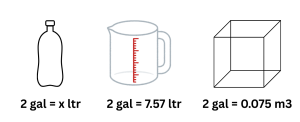The Volume Units Converter is an easy-to-use tool that helps you convert between units like liters, cubic centimeters, cubic inches, and more. Our volume converter is built using internationally recognized SI standards to ensure precision and reliability every time. It minimizes mistakes by giving quick and accurate results no matter which units you need. Also, is designed to be used by for students, professionals, or anyone working with volume measurements.
What Is Volume?
Every 3D shape that we see around us and occupies space is defined as a volume. These shapes can be different from each other, like a cube, cuboid, sphere, and other forms. When we may fill with water an aquarium that can have the shape of a cube, finding the volume helps to know the amount of water required to fill it.Common Volume Units
- Liter (L): Standard metric unit used in most countries for measuring liquids.
- Milliliter (mL): 1/1000 of a liter; common in medicine and cooking.
- Cubic Meter (m³): Often used in construction, water tanks, and bulk materials.
- Gallon (gal) – Common in the U.S. and UK
- Cubic Inch (in³) – Imperial unit used in engine displacement and product packaging.
Why Volume Conversion Is Important
When doing conversion, you may end up having some bad calculations. The reason may be that unit systems like metric and imperial have different rules of conversion. So, the do the right conversion, you may need a tool like our Volume Unit Converter. Volume conversion is essential in many fields like shipping, scientific experiments, and construction. For example, in construction, properly converting units helps estimate material requirements and control project costs more efficiently.
What It Does, Who It’s For, and How to Use the Volume Unit Calculator?
The Volume Units Converter helps you quickly and accurately switch between different volume measurements, whether metric or imperial. It is perfect for professionals, students, and anybody working with liquids, containers, or 3D measurements since it is made to minimize calculation mistakes and save time. You just need to input the value, chose the units and then you get the converted value instantly.
The Volume Units Converter is ideal for:
- Students and teachers in science and math.
- When cooking, working with international recipes.
- Engineers who work with various volume units.
How to Use Volume Unit Converter:
- Enter the value you wish to convert.
- Select the unit you are converting from.
- Choose the unit you want to convert to.
- Click “Calculate” to view the result instantly.
Frequently Asked Questions (FAQs)
1. Does density affect volume conversion?
No. A volume converter only deals with space (volume), not mass or weight. Density matters only if you’re trying to convert between volume and mass.
2. How do I calculate volume if I only have the length, width, and height?
Use the formula for the shape. For a box, multiply length × width × height to get cubic units (like cm³). Then convert that result into the volume unit you need, such as liters or m³.
3. When should I use cubic meters (m³) instead of liters (L)?
Use cubic meters for big measurements, like construction, shipping, engineering, and storage. Use liters for everyday things like liquids, bottles, cooking, and small containers.
4. What mistakes do people commonly make with volume conversions?
The biggest mistake is mixing up US and UK (Imperial) units. For example, a US gallon is smaller than an Imperial gallon, so choosing the wrong one gives incorrect results.
5. Should I round my answer during the conversion?
Avoid rounding in the middle of calculations. Keep the exact values while converting, and round only the final result if needed.
6. Why should I understand volume conversions if I already use a calculator?
Knowing the basics helps you notice mistakes, like selecting the wrong unit system, and prevents errors in real-life situations.
Explore More of Our Tools
Discover additional calculators that can help you with a variety of everyday tasks and calculations. These calculators are designed to help you solve a wide range of everyday problems quickly and accurately. Our site offers a variety of helpful calculators designed to make your life easier. Click on any of the tools below to explore related calculators and discover more ways to quickly perform everyday calculations.
Temperature Converter →
Helps you to convert form units like grade Celsius, Fahrenheit and Kelvin.
Mass Units Converter →
Converts between gram, kg, tonne, lbs, and other common mass units.
Pressure Unit Converter →
Helps you to convert form units like pascal, atm, psi, bar, and more.